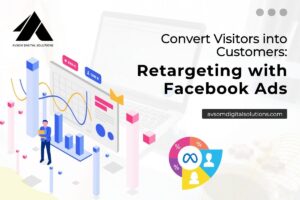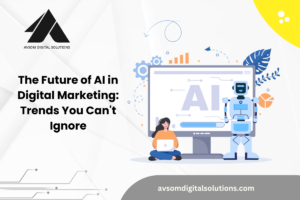In the fast-evolving landscape of digital marketing, social media stands as a powerful platform for businesses to connect with their audience. Two primary strategies dominate this space: social media advertising and organic reach. Understanding the strengths and weaknesses of each approach is crucial for brands looking to maximize their online presence. At Avsom Digital Solutions, we delve into the intricacies of these strategies to help you determine what works best for your brand.
Understanding Social Media Advertising
Social media advertising involves paying to promote your content on platforms like Facebook, Instagram, Twitter, LinkedIn, and others. These ads can take various forms, including:
- Sponsored Posts: Paid promotions that appear in users’ feeds.
- Display Ads: Banner ads that appear on the side or within the platform.
- Video Ads: Short videos that play before, during, or after other video content.
- Carousel Ads: Multiple images or videos in a single ad that users can swipe through.
- Stories Ads: Full-screen ads that appear in the stories section of social media platforms.
- Benefits of Social Media Advertising
Targeted Reach: Social media platforms offer sophisticated targeting options, allowing you to reach specific demographics based on age, gender, location, interests, and behavior. This precision helps ensure your ads reach the most relevant audience.
Immediate Results: Unlike organic reach, which can take time to build, social media advertising delivers immediate visibility and engagement. This is particularly useful for time-sensitive campaigns or product launches.
Scalability: With social media advertising, you can scale your campaigns based on your budget. This flexibility allows businesses of all sizes to compete and reach their target audience effectively.
Measurable ROI: Social media advertising platforms provide detailed analytics and insights, enabling you to track the performance of your campaigns. Metrics like impressions, clicks, conversions, and engagement help measure the return on investment (ROI).
Challenges of Social Media Advertising
Cost: Advertising on social media requires a budget, and costs can add up quickly, especially in competitive industries. Small businesses might find it challenging to allocate sufficient funds for sustained campaigns.
Ad Fatigue: Users may become overwhelmed by the volume of ads they encounter, leading to ad fatigue. This can result in decreased engagement and effectiveness over time.
Algorithm Changes: Social media platforms frequently update their algorithms, which can impact the visibility and performance of your ads. Staying updated with these changes is essential for maintaining campaign effectiveness.
Understanding Organic Reach
Organic reach refers to the visibility and engagement your content receives without paid promotion. It relies on the natural interactions of users with your posts, stories, and other content.
Benefits of Organic Reach
Cost-Effective: Organic reach does not require a financial investment, making it an attractive option for businesses with limited budgets. It relies on creating high-quality, engaging content that resonates with your audience.
Authenticity: Organic content often feels more genuine and trustworthy to users compared to paid ads. Building an authentic connection with your audience can lead to higher levels of trust and loyalty.
Long-Term Results: While organic reach may take time to build, it can lead to sustained engagement and visibility. Consistently posting valuable content can establish your brand as an authority in your industry.
Community Building: Organic reach encourages interactions, conversations, and community building. Engaging with your audience through comments, likes, and shares fosters a sense of belonging and loyalty.
Challenges of Organic Reach
Algorithm Limitations: Social media platforms prioritize content based on algorithms, which can limit the visibility of organic posts. Brands may struggle to reach their audience if their content does not perform well according to these algorithms.
Time-Consuming: Building a strong organic presence requires consistent effort and time. Creating high-quality content, engaging with followers, and monitoring performance can be resource-intensive.
Unpredictable Growth: Unlike paid advertising, which can deliver immediate results, organic growth is often slow and unpredictable. Brands must be patient and persistent to see significant results.
Comparing Social Media Advertising and Organic Reach
To determine which strategy works best for your brand, it’s essential to compare social media advertising and organic reach based on several key factors:
1. Cost
Social Media Advertising: Requires a budget for ad spend, but offers precise targeting and immediate results.
Organic Reach: Cost-effective as it does not require financial investment, but demands time and effort to build a strong presence.
2. Time to Results
Social Media Advertising: Delivers immediate visibility and engagement, making it ideal for short-term campaigns and promotions.
Organic Reach: Takes time to build, but offers long-term benefits and sustained engagement.
3. Targeting
Social Media Advertising: Offers advanced targeting options to reach specific demographics, interests, and behaviors.
Organic Reach: Relies on the natural interactions of users, making targeting less precise and dependent on content performance.
4. Authenticity and Trust
Social Media Advertising: Can be perceived as less authentic due to its paid nature, but effective ad creatives can still resonate with audiences.
Organic Reach: Builds authenticity and trust through genuine interactions and valuable content.
5. Scalability
Social Media Advertising: Easily scalable based on budget, allowing businesses to increase or decrease ad spend as needed.
Organic Reach: Scalability is limited by the time and effort required to create and promote content.
Integrating Social Media Advertising and Organic Reach
At Avsom Digital Solutions, we believe that the most effective social media strategy often involves a combination of both advertising and organic reach. Integrating these approaches allows brands to leverage the strengths of each while mitigating their weaknesses.
Creating a Balanced Strategy
Start with Organic: Begin by building a strong organic presence. Focus on creating high-quality, engaging content that resonates with your audience. Use organic reach to establish authenticity and trust.
Amplify with Advertising: Once you have a solid organic foundation, use social media advertising to amplify your reach. Promote your best-performing organic content to a wider audience and drive immediate engagement.
Retargeting: Use social media advertising for retargeting campaigns. Target users who have interacted with your organic content or visited your website. This helps reinforce your brand and encourages conversions.
Analyze and Adjust: Continuously monitor the performance of both your organic and paid efforts. Use analytics to identify what works best and adjust your strategy accordingly.
Case Study: Successful Integration
One of our clients, a mid-sized e-commerce brand, successfully integrated social media advertising and organic reach to achieve remarkable results. Here’s how they did it:
Organic Content Strategy: The brand focused on creating valuable content, including blog posts, product tutorials, and customer stories. They used a mix of images, videos, and interactive posts to engage their audience.
Community Building: They actively engaged with their followers by responding to comments, hosting live Q&A sessions, and creating user-generated content campaigns.
Targeted Advertising: They used social media advertising to promote their best-performing organic content. By targeting specific demographics and retargeting website visitors, they achieved higher engagement and conversions.
Continuous Optimization: The brand continuously monitored the performance of their campaigns and adjusted their strategy based on the insights gained. They experimented with different ad formats, targeting options, and content types to maximize their ROI.
As a result, the brand saw a significant increase in website traffic, engagement, and sales. The combination of a strong organic presence and targeted advertising helped them build a loyal customer base and achieve their business goals.
Best Practices for Social Media Advertising
To maximize the effectiveness of your social media advertising efforts, consider the following best practices:
Define Clear Goals: Set specific, measurable, and achievable goals for your advertising campaigns. Whether it’s increasing brand awareness, driving website traffic, or boosting sales, having clear objectives will guide your strategy.
Know Your Audience: Use the advanced targeting options available on social media platforms to reach your ideal audience. Understand their demographics, interests, and behaviors to create relevant and engaging ads.
Create Compelling Ad Creatives: Invest in high-quality visuals and engaging copy to capture your audience’s attention. Use a mix of images, videos, and interactive content to keep your ads fresh and appealing.
Test and Optimize: Continuously test different ad formats, targeting options, and creatives to identify what works best. Use A/B testing to compare the performance of different elements and optimize your campaigns accordingly.
Monitor and Analyze: Regularly monitor the performance of your ads using the analytics provided by social media platforms. Track key metrics such as impressions, clicks, conversions, and ROI to measure the success of your campaigns.
Best Practices for Organic Reach
To build a strong organic presence and maximize your reach, consider the following best practices:
Consistent Posting: Maintain a consistent posting schedule to keep your audience engaged. Regularly share valuable content that resonates with your followers and encourages interactions.
Engage with Your Audience: Actively engage with your followers by responding to comments, messages, and mentions. Foster a sense of community by encouraging conversations and interactions.
Leverage User-Generated Content: Encourage your followers to create and share content related to your brand. User-generated content not only builds authenticity but also extends your reach to new audiences.
Use Hashtags Strategically: Use relevant hashtags to increase the discoverability of your content. Research popular and trending hashtags in your industry and incorporate them into your posts.
Analyze Performance: Regularly analyze the performance of your organic content using social media analytics. Identify what types of content resonate most with your audience and adjust your strategy accordingly.


